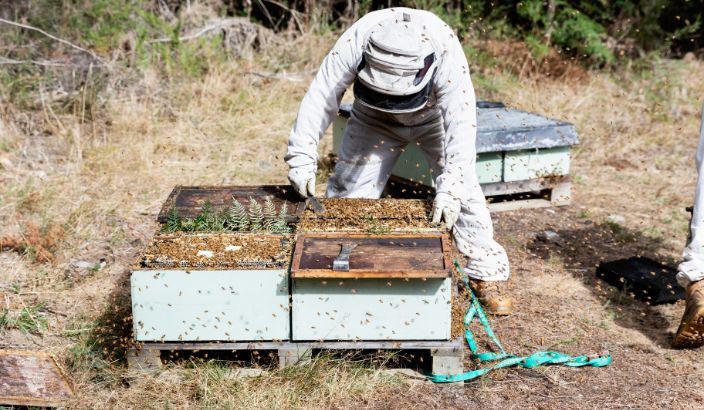Season struggle for beekeepers

Beekeepers at Rainbow Honey working at one of their Tasman hives as they navigate a challenging season impacted by weather, drought, and market struggles. Photo: Rainbow Honey.
Lower summer weather temperatures, drought conditions in some areas, and honey prices still struggling have left many beekeepers grappling with unexpected challenges. In response to these difficulties, Waimea Weekly reached out to local beekeepers to see how these factors have affected honey production and what the future holds for those who depend on the industry.
Wakefield-based beekeeper and queen bee breeder Nick Milne describes the season as “messy”.
“It started off looking promising, but the weather turned, and it quickly became a very average season, with the quality of mānuka honey falling below expectations. Overall, it’s been a messy season due to the weather,” he says.
Nick also emphasises the importance of managing hive health, particularly about varroa – a microscopic mite that parasitises honeybees, leading to reduced honey production and a nationwide issue.
“Our hive health and strength are exceptional right now, thanks to the hard work of our team. However, it’s vital that beekeepers re-treat their hives for varroa in autumn to ensure strong colonies heading into spring.”
Philip Cropp of Rainbow Honey and Nelson Honey, which operate hives across Saint Arnaud, Westport, Greymouth, and Ross, with a honey extraction and processing plant in Tapawera, shares that while their season has been above average, this success is largely due to an exceptional rātā flowering season on the West Coast.
“The rātā has flowered well, and bees love rātā. The West Coast had a tough spring but enjoyed better weather than Nelson and Tasman during the early summer months, resulting in a below-average mānuka season but an above-average rātā season.”
Derek Bensemann, manager at Rainbow Honey, highlights that production costs remain high.
“Labour costs have increased, along with varroa treatment strips, and the labour required to apply these treatments and conduct hive inspections,” he explains.
Derek also notes that some beekeepers are cutting corners by not treating their hives for varroa in an attempt to reduce costs.
However, with drones (male bees) visiting multiple hives, this practice is only spreading varroa to otherwise healthy hives.
“Even when we have clean hives, drones visit and carry varroa from those taking shortcuts,” he adds. The market outlook is also bleak.
"The market is as bad as it has ever been. While we have seen some increased interest from buyers, this hasn’t been reflected in any meaningful price increase, so it’s still very challenging,” Nick says.
“It can’t get any worse, so it must get better,” Philip echoes.
